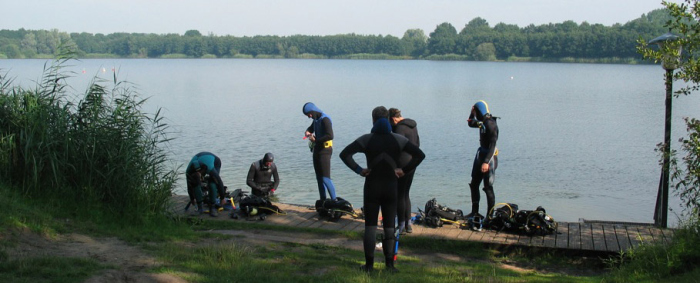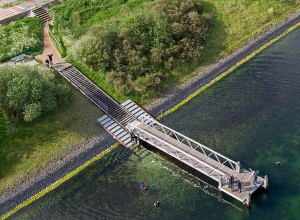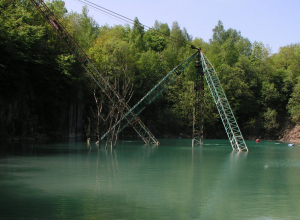Diving in Dutch sand quarries

What you need to think of when diving in Dutch sand quarries. A few factors can influence the dive circumstances. The season, the weather, the vegetation on the banks, the water temperature and the species in the water all are affecting the conditions of the water. Take a look in the DIVERS GUIDE app or on www.duikergids.nl to get an actual representation from log files and divers’ reviews.
How will you handle visibility in fresh water? Verify how the visibility has developed the last few weeks and on what days the dive spot is busy. Calculate in environmental influences like rain or strong winds. In some spots visibility is always bad after periods of warm weather or extended periods of rain. This is commonly noticed at dive spots with little vegetation on the banks thus sand and mud easily get washed into the water. In river’s side arms the water level is important but this can differ between dive spots. Get information from local divers about water levels and their influence on the water’s visibility.
Visibility and bottom composition
An important indicator for visibility underwater is the composition of the bottom. In some dive spots lies lots of iron scrap. De tiny rust particles, that originate from oxidation, give the water a brownish colour and limit visibility. Peat also has a negative effect because it also colours the water kind of darkish. Furthermore peat tends to whirl up quite easily. A sandy bottom is better because sand is relatively heavy. Besides that sand often has a lighter colour thus reflecting more sunlight. Sandy bottoms can be divided into three zones; close to the banks you’ll find a layer of black soil, this is the mud that flows into the water during rainfall. Behind this zone comes a fairly wide strip of sand, this is the zone with probably the best visibility. At greater depth you often find another zone where fine silt has gathered into a thick layer. This is often the spot where the sand suction units were placed. One finkick here can reduce visibility to zero.
The species’ effect on visibility
Life itself can affect visibility in a dive spot. Some species of carps churn up the bottom while feeding. With a large population of carps this might have noticeable influence on visibility. Algae bloom is a disaster for visibility as the phenomena occurs while the water temperature rises and the oxygen level falls. The water turns green and visibility drops to almost zero. Zebra mussels however are a blessing for the water’s visibility, them being small filtration installments who continuously absorb nutrients out of the water. Whenever you see colonies of zebra mussels you’ll know that that is almost a guarantee for clear water. You will also need to take a look at all the other circumstance that stir up the water and with that cause floating debri and silt. Wind, surf, waves, many bathing or diving people, that are all signs that visibility might be not as good as wished for.
Glauconite content
Netherlands has a few dive spots with an enriched glauconite content. In these dive spots the water has a significant blue colour and visibility is often very good. The Galderse Meren and ‘t Blauwe Meer in Noord Brabant are a few examples, but Botjes Zandgat in Groningen is one more. The latter is not diveable yet because it is still being excavated but visibility reaches here up to twenty meters, quite unique for Dutch waters. On the other hand is the marine life in these dive spots not too abundant and sometimes even almost null. In ‘t Blauwe Meer you’ll find eels as thick as an arm and shoals of perch, only in de Galderse Meren you’ll find nothing but a few beetles and Mayfly larvae. All of this is compensated by the spectacular visibility and the blue colour of the water that almost gives you that Mediterranean feeling.
Biodiversity
What do you look for when it comes to the biodiversity of a sand quarry? De shoreline vegetation tells a lot about life in the lake. Lots of vegetation indicates it is an older lake where life has had the time to develop. Water plants form a good hiding place for fish. Also look for signs that indicate that the lake is visited by fishermen because that tells you fish stock are good or are even maintained by restocking fish in the lake. Freshwater life in sand pits can also be divided into zones. Divers will see most life in the shore zone. Up to ten meters depth you will find a diversity of plants, like hornwort, waterweed, naiad and stonewort. In between and on these plants it often teems with life but you have to do a good search to discover it. This is also the zone where you’ll find most fish. Deeper than meters plant life will soon diminish because of the lack of light, unable to protrude this deep. On the other hand you can still find shoals of fish and the bigger solitary fish at deeper depths.
Freshwater life
The freshwater life is pretty similar among most freshwater dive spots. The known species are among others: Pike, pikeperch, roach, stickleback, carp, bream and eel. In the Meuse’s side arms the diversity is greater where you might find catfish, mitten crabs, gobies and lots of other species. How might you enhance the chance to spot fish? Especially in the shore zone chances are best to find fish. Look in between reeds, tree roots, tree branches hanging in the water and stones and rocks. Areas with lots of plants function as a nursery for young fish. Chances are high to see shoals of young fish here, but that’s of course also the place to find the predators that feed on them. Search for underwater objects like car wrecks or tubes because those are excellent places for pikes and pike-perch to hide in. Big predator fish often rest on sandy bottoms at greater depths. The famous sand quarries in Netherlands that are frequently visited by divers amongst others are: De Vinkeveense Plassen, Eiland 4, De Beldert, the Toolenburgerplas and the Haarlemmermeerse bos.











Comment to this article